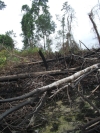 Indonesia still has one-tenth of the world's remaining rainforests, a treasure trove of rare plant and animal species, including critically endangered tigers, elephants and orang-utans. It is the third largest tracts of tropical rainforest, after Brazil and the Congo, despite losing one-quarter of its forest cover in the last 15 years. Tthe high deforestation rate made Indonesia the world's third largest emitter of greenhouses gases after the US and China.
Indonesia still has one-tenth of the world's remaining rainforests, a treasure trove of rare plant and animal species, including critically endangered tigers, elephants and orang-utans. It is the third largest tracts of tropical rainforest, after Brazil and the Congo, despite losing one-quarter of its forest cover in the last 15 years. Tthe high deforestation rate made Indonesia the world's third largest emitter of greenhouses gases after the US and China.
Although the Indonesian government is committed to reducing deforestation and greenhouse emissions, Indonesian forests are quickly vanishing. According to The Independent, illegal logging only is responsible for the loss of 10 million hectares of forest.
Indonesia is already responsible for 8 per cent of global carbon emissions. The recent government report forecast that carbon emissions, which have risen from 1.6 billion tons in 1990, will increase to 3.6 billion by 2030, a leap of 57 per cent from today's level. The main reason is logging and clearing of forests for industrial plantations, mostly oil palm and Acacia, driven from the international marked demand of products such as biofuel and paper. The government already announced plans do double palm oil production, and for new Acacia plantations. The rapid expansion of oil palm and acacia plantations in Sumatra and Borneo is threatening the orang-utan's forest habitat and hastening its extinction.


